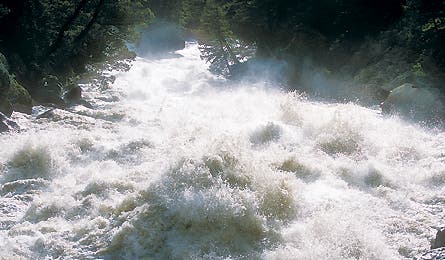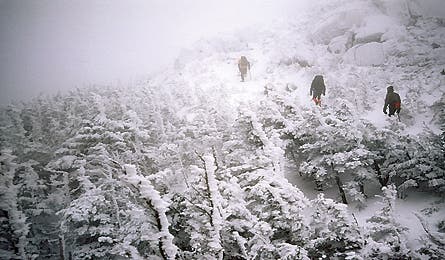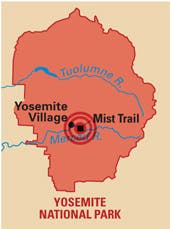Natural Born Killers: Top Backcountry Dangers

'(Photo by Michael Francis)'

(Photo by Michael Francis)

(Photo by Mark Carroll)
The wilderness is a safe and peaceful place to spend a weekend, right? Almost always, yes. But hikers who venture into the woods without a healthy respect for natural hazards–bears, storms, rivers, snakes, and more–are asking for trouble. Of course, not all threats are equally dangerous–or deserve the nightmares we have about them. Hikers freak out about a few mountain lion attacks, but hypothermia kills a lot more people on the trail. To put the risks in perspective, we ranked the top 22 dangers with our exclusive Terror Index, a formula that measures prevalence, geographic distribution, average body count, and–most importantly–the level of suffering involved. To improve your odds, we also boiled the advice of numerous experts down to a few easy-to-recall tips for every threat.

190 WATER
Danger Drowning; getting pummeled against rocks, rag-dolled through flash floods, washed over waterfalls
Body count Water mishaps rank second among outdoor deaths, but slightly edge out falls on our index because of the prolonged panic of not breathing. Drowning involves excruciating pressure in your lungs as carbon dioxide builds to unbearable levels–but worst of all, you’ll be fully aware that you’re dying for the four to five long minutes it can take before you mercifully pass out.
Best defense Don’t cross fast-moving rivers that are more than knee deep. Stay out of slot canyons when flood-producing heavy rains threaten. Never cross a frozen lake or river unless you’re certain the ice is continous and at least four inches thick.
186 GRAVITY
Danger Broken neck; brain and internal injuries
Body count Unroped falls are the outdoors’ number-one killer, and the majority of victims are hikers, not climbers. A dayhiker falls almost every week in the backcountry; in national parks in Washington and California, accidental falls make up the biggest chunk of fatalities each year.
Best defense Stay in your comfort zone, and always ask yourself: What are the consequences if I fall here? Never climb something you can’t get down, or let anyone push you beyond your limits.

182 HEART ATTACKS
Danger Uncomfortable squeezing in the chest that gradually becomes more intense as the heart is starved of oxygen.
Body count Cardiac arrest ranks nearly as high as drowning for deaths in the backcountry. Altitude, vigorous exercise, and reduced oxygen levels can exacerbate existing medical problems and trigger an attack. Even scarier: Half of all heart attacks kill before help arrives.
Best defense If you’re over 40 and unaccustomed to strenuous activity, ask your doctor about taking a stress test before attempting any serious hiking, especially at higher altitudes.
162 LIGHTNING
Danger A 50,000°F bolt of electricity that sears your skin, makes your muscles spasm, and in some cases, stops your heart instantly.
Body count Last year, lightning killed 45 people in the United States, including four hikers and five anglers. July is the deadliest month; this year, at press time, 23 people had already gotten shocked.
Best defense Get below treeline well before summer mountain thunderstorms roll in (most strikes occur in the afternoon). If you’re caught in an exposed location, discard any metal objects and crouch on your sleeping pad. Stay 20 feet apart from others so that one bolt doesn’t incapacitate an entire group. Administer CPR immediately to strike victims who aren’t breathing.
156 COLD
Danger Frostbite, trench foot, and hypothermia–which leads to a drop in core temp, coma, and death
Body count Cold claims about 600 victims each year in the U.S. Of the 137 total deaths reported on Mt. Washington since 1849, 20 percent were due to hypothermia (second only to falls). And it doesn’t take much: A few inactive hours in freezing, windy weather will turn your muscles to bricks–meaning you’ll stumble, collapse, and pee your pants before dying.
Best defense Pack as if you might have to survive a night out. Put on warm, dry layers and stay under shelter if you start to shiver and lose coordination. Hypothermia can kill in temps as high as 50°F, and wet clothes increase conductive heat loss by a factor of five.
142 MOUNTAIN LIONS
Danger A snapped neck after the alpha predator sinks its teeth into your spinal cord
Body count Cougars kill an average of one person and injure six each year in the U.S. Kids, trail runners, and mountain bikers are most at risk (anyone small or moving quickly can trigger a lion’s hunting instinct). Based on fatalities alone, mountain lions barely rank, but they rose this high on intent: They’re hunting you.
Best defense Don’t hike alone at dawn and dusk, especially in California and Colorado, where most attacks have occurred. If you are ambushed, fight back. Cougars will quickly realize you’re not a deer.

141 BEES
Danger Airway constriction caused by anaphylactic shock chokes you to death if you’re one of the 3 percent of allergic adults. Think you’re safe? Not so fast. If you’ve only been stung once, the body hasn’t yet had time to mount an allergic response. The second sting could kill.
Body count Wasps, bees, and hornets are responsible for an average of 50 deaths a year. Among venomous animals, bees and their kin account for 70 percent of all deaths–10 times more than snakes. And it’s quick: Anaphylaxis can kill in less than 10 minutes.
Best defense Avoid scented sunscreens and bright clothing, which can attract bees. Carry an antihistamine like Benadryl in your first-aid kit, and an EpiPen if you or your hiking partners are allergic.
139 MOSQUITOES
Danger West Nile Virus, a bug-borne disease that attacks the brain and spinal cord, causing stupor, disorientation, tremors, coma, and death in severe cases
Body count Most victims are very young or old, but more than 1,000 in 46 states have died since the disease surfaced in 1999 (284 in 2002, the deadliest year on record.) Idaho, Mississippi, and Wyoming had the highest per capita death rates in 2006.
Best defense There’s no treatment, so prevent bites by wearing long sleeves and pants at dawn and dusk and using a DEET-based bug spray. And should you be tempted to handle a dead bird (seek help, friend), note that they’re WNV carriers, especially robins and crows.
134 YOUR EGO
Danger Getting lost, stranded, or smashed up, thanks to your deadly combination of overconfidence and lack of know-how
Body count Insufficient experience and errors in judgment played a role in one-third of the 3,593 SAR operations in the national park system last year, with poor physical condition also implicated in 22 percent of all cases.
Best defense Assess your skills and experience level honestly, take classes to improve, and resist the urge to climb or cross risky terrain.
132 HEAT
Danger Delirious convulsing that progresses to multiple organ failure and dying brain cells when core body temperature hits the 104°F range
Body count Between five and 10 people die each year of heat-related causes in Grand Canyon National Park, accounting for a quarter of all park fatalities. If the Southwest is your destination, you should fear heat a lot more than bears. Best defense Treat victims by cooling them immediately with water (soak their skin and clothing, and apply wet cloths to the neck, groin, and armpits), fanning them, and having them recline in a shady spot. Never leave someone experiencing heat illness alone.

130 SNAKES
Danger Hemotoxic venom that causes intense pain, swelling, hemorrhaging, and organ failure
Body count Approximately 7,000 people suffer venomous snakebites each year, and an average of six die. Diamondback rattlesnakes account for 95 percent of all serpent fatalities; highly aggressive western diamondback rattlers live in the Southwest, while the larger eastern variety ranges from North Carolina to Louisiana.
Best defense Here’s an idea: Don’t harass a venomous snake. A full two-thirds of bites result from victims intentionally messing with a fanged reptile. Keep your eyes peeled when walking through tall grass or gathering firewood; when scrambling, avoid unseen handholds on sunny ledges where rattlers like to bask.
129 AVALANCHE
Danger Slow suffocation under a crushing mound of snow–or hypothermia, if your oxygen lasts that long
Body count It’s not just backcountry skiers who are at risk: Last year, six of the 33 people killed by avalanches in the U.S. were hikers and snowshoers.
Best defense Take a course in recognizing snow hazards. Check the avalanche report before departing. If you’re caught, shed skis, try to swim for the surface as the slide slows, and create an air space by placing your hands in front of your face.
124 RULON GARDNER
Danger Bad luck. The 37-year-old Olympic-champion wrestler has survived: a plane crash in Lake Powell (after which he swam for more than an hour in 44°F water and made it through a night without shelter); a snowmobile accident in the Idaho wilderness (after which he was stranded for a night in -25°F weather and lost a toe to frostbite); a motorcycle crash; and an arrow to the gut.
Body count None … yet.
Best defense Decline all invitations to join Gardner on any outdoor adventure. In fact, avoid Gardner altogether.
120 ROCKS
Danger A volleyball-size chunk of granite hurtling toward your head at terminal velocity
Body count Accidents in North American Mountaineering reported a total of 610 deaths or injuries from falling rocks or ice between 1951 to 2006. And in 1996, a 30,000-cubic-yard rockslide in Yosemite’s Happy Isles area killed one hiker and seriously injured several more.
Best defense Don’t hike/scramble below others, who may knock rocks loose. Wear a helmet on steep routes, look out for debris on the trail, and watch for rockfall after springtime freeze-thaw cycles.

118 SPIDERS
Danger Extreme pain, severe muscle cramps, respiratory paralysis, and necrotic ulcers (translation: your flesh rots)
Body count About six people die from bites each year, primarily from black widow or brown recluse spiders. Backpackers who are bitten often encounter the arachnids at night in their tents, though the bites–initially painless–can go undetected for hours. True, the overall number of fatalities isn’t high, but spiders get extra points for causing a very slow, feverish, gut-cramping, skin-blistering demise. Plus, they’re creepy.
Best defense As with snakes, be careful when collecting firewood and climbing ledges–and when sitting down in an outhouse. Take extra precautions in the South, where half of fatal spider bites occur.
114 BEARS
Danger A bloody, skull-crushing, flesh-ripping encounter with four-inch claws and dagger-like teeth–wielded by 400 pounds of muscle
Body count In North America, black bears have killed 56 and grizzlies 52 since 1900 (mostly in Canada). And the pace is picking up: At least 15 of the black-bear fatalities have occurred since 2000.
Best defense In most cases, simply announcing “Hey bear!” as you hike will warn bruins of your approach and prevent encounters. In camp, cook and store food according to local park rules. If attacked, fight back against a black bear and play dead with a grizzly. But if a grizzly starts to gnaw on your leg, fight back like your life hangs in the balance–it probably does.
109 YOUR CELL PHONE
Danger Stupidly walking into a dangerous scenario, assuming that your technology will always get you out safely
Body count Good news: Cell phones and GPS are more likely to save you than doom you. Most Backpacker editors carry both because they know the devices boost safety–if used correctly. Bad news: Technology can also breed a dangerously false sense of security. Anecdotal evidence from SAR professionals nationwide suggests over-reliance on electronics is getting more novice hikers into trouble–with potentially disatrous results.
Best defense Digital devices are only as smart as their users. Bring yours, but don’t forget that basic safety gear (including a map/compass for backup navigation), wilderness training, alertness, and common sense are your first lines of defense.
99 BRAIN-SUCKING AMOEBAS
Danger Invisible Naegleria fowleri, a freshwater nasty that crawls up the nostrils of unsuspecting swimmers, then eats its way through their brains and spinal cords. Though rare, death is swift–usually following within a week.
Body count N. fowleri have killed 23 people since 1995, including a teenage boy who died last September after a swim in Arizona’s Lake Havasu. Hot springs and warm-water lakes and rivers in the South and Southwest are the amoeba’s favorite slurping grounds; risk of infection peaks during heat waves, when the water is hotter and lower than usual.
Best defense Nose clips
92 ALLIGATORS
Danger A cold-blooded predator that grasps you in powerful jaws (capable of closing with a force of 3,000 psi) before executing the well-named death roll” to break bones, shred tissue, and drown you
Body count Gators are responsible for more than 20 deaths since 1948 (most of them in Florida) and have bitten more than 375 people. Most victims were attacked on golf courses and residential canals, but canoeists and snorkelers in national forests and state parks have also been killed. Odds are low, but the mere thought of being attacked by a primordial 10-foot reptile will keep us up at night in the Everglades.
Best defense First and foremost: Don’t join the 17 percent of victims who try to capture, poke, or harass a gator.
89 GLASTENBURY MOUNTAIN
Danger Vanishing without a trace
Body count Native American legend held that this Vermont peak was cursed, but it took five people disappearing under mysterious circumstances between 1945 and 1950 on or near the Green Mountain summit–part of the Appalachian and Long Trails–to enhance the area’s reputation as a suspected paranormal hotspot (the Bennington Triangle) or home to a fearsome, Bigfoot-type beast. Only one of the victims’ bodies was recovered, and all the cases remain unsolved.
Best defense Hike with a buddy, and avoid Glastenbury during the full moon and on Halloween (just in case).
89 ANIMAL COLLISIONS
Danger Being impaled on an 800-pound elk’s aspen-sharpened antlers after it smashes through your windshield on your way to the trailhead
Body count 1,646 people died in animal-vehicle contests in the U.S. between 1995 and 2004–mostly after crashing into deer–and accidents have increased along with rising ungulate populations. Especially beware the deadly moose. Hitting one of these 1,000-pound beasts is 30 times more likely to kill you than hitting a deer.
Best defense Be alert for moose on the roadside, especially on summer evenings: 75 percent of moose collisions occur at night, and fatalities peak in June. But don’t let your guard down come September: Deer-car crashes are at their highest in the fall.
81 OTHER PEOPLE
Danger Guns, knives, blunt objects–or being pushed off a cliff, as happened twice in national parks in 2006
Body count National parks average 12 murders per year; the overall frequency of violent crime in national parks is one attack per one million visitors (remarkably low compared to the 2006 national average of 473 violent crimes per 100,000 people). And not all shootings are intentional: A hunter mistakenly shot an AT hiker in northern Georgia in 2002.
Best defense Hike away from suspicious people at shelters and near road crossings, where most trouble occurs. Wear bright orange clothing during hunting season. Stay calm if threatened on the trail; give up your wallet if the stranger has a weapon, but fight back if attacked.